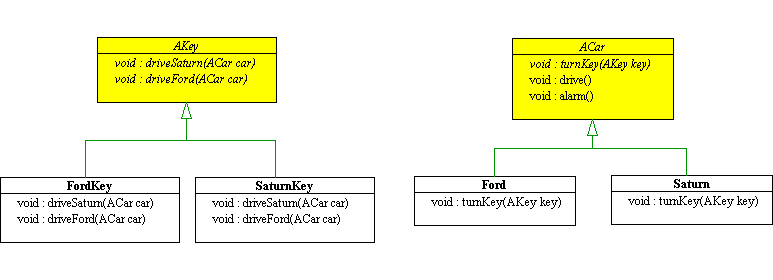
This tutorial consists of exercises on the visitor pattern discussed in class. It also helps prepare for homework 03.
Consider the following UML model of keys and cars:

You are to do the following:
1. Fill in the concrete methods of all the above concrete classes so that only a specific key will drive a specific car when that car's turnKey() method is called with that key, i.e. call its drive() method. All other keys will call the car's alarm() method.
For instance, suppose we have:
- An object called ford of type Ford, and
- An object called fordKey of type FordKey
then ford.turnKey(fordKey) will cause ford.drive() to be called.
On the other hand, suppose instead we have
- An object called saturnKey of type SaturnKey
then ford.turnKey(saturnKey) will cause ford.alarm() to be called.
2. Fill in the ACar.drive() and ACar.alarm() methods to print out something indicative that the method has been called, e.g. "Car has been driven!" and "Car alarm sounded!".
3. Document your code, of course. It is recommended that you document the methods before you write the method bodies! (Remember Comp210?)
3. Write a test program that clearly tests all possible key and car combinations. Be sure that the test program prints clear messages indicating exactly what is being tested at the moment, i.e. what key-car combination is being used.
Create the object system that models the following using the Visitor Design pattern:
You're sitting in your room...um...."working"....or maybe not..... Suddenly, the phone rings and some person is on the other end. You need to proffer a response, but the exact response behavior will depend on not only what you've been doing, but who the person on the line is.
Now, there are a couple of scenarios:
Some things to consider:
You are required to do the following:
First, copy OOscheme.jar from the link http://www.owlnet.rice.edu/~comp212/02-springl/lectures/08/OOscheme/OOscheme.jar/.
OOscheme.jar contains the jar byte code for the package OOscheme. Use the provided java classes as the starting point.
You can compile any code that makes use of the OOscheme.jar using the command:
javac -classpath .:OOscheme.jar your-java-source-code.
Here we assume OOscheme.jar is in the directory of your java source code. If not, you will need to provide the full path name to OOscheme.jar.
Additonal jar files can be specified by separating them with colons (Solaris) or a semicolon (Windows) above.
To run your program using the code in the jar file, you need to override the classpath in use to include the jar file: (Solaris example)
java -classpath .:OOscheme.jar your-java-class-file.